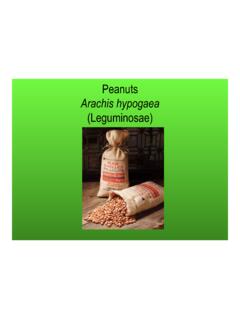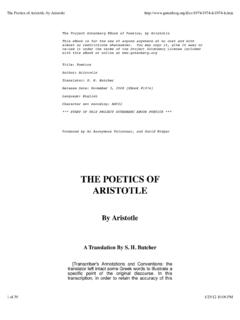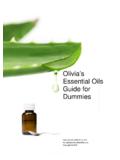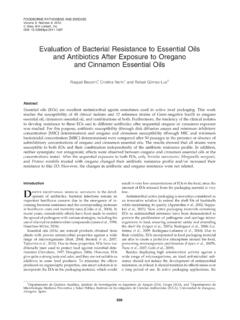Transcription of Making Sense of Olive Oil: Simple Experiments To Connect ...
1 Making Sense of Olive Oil: Simple Experiments To Connect SensoryObservations with the Underlying ChemistryRichard A. BlatchlyDepartment of Chemistry, Keene State College, Keene, New Hampshire 03435, United StatesZeynep DelenEge de Ato lye Dernegi, Taksim Beyoglu, Istanbul, 34437, TurkeyPatricia B. O Hara*Department of Chemistry, Amherst College, Amherst, Massachusetts 01002, United States*SSupporting InformationABSTRACT:In the last decade, our understanding of the chemistry of Olive oil hasdramatically improved. Here, the essential chemistry of Olive oil and its important minorconstituents is described and related to the typical sensory categories used to rate andexperience oils : color, aroma, bitterness, and pungency. We also describe Experiments toexplore some of the characteristics of Olive oil related to its status as a new health qualitative Experiments on Olive oil can be done in conjunction with tastings of theoil. First, we establish the relationship between the color of an object and the absorption oflight by its molecular constituents using gummy candies and laser pointers.
2 Then, the colorof the various oils can be measured quantitatively using an iPhone app (Irodori).Illuminating the oil with a green laser produces a startling redfluorescence in the presenceof the natural chlorophyll in some Olive oils . Relatively straightforward colorimetric assayscan reveal the presence of unsaturated fatty acids, healthy antioxidants such as phenols(unique to Olive oils ), contaminating peroxides, and the level of free fatty acid that is atelltale sign of poorly treated or stale oils . Afinal comparison of the sensory observationsfrom tasting with the chemical and spectroscopic analysis provides an introduction to the science behind food standards and thesensitivity of our own sensory :High School/Introductory Chemistry, First Year Undergraduate/General, Second-Year Undergraduate,Interdisciplinary/Multidis ciplinary, Laboratory Instruction, Public Understanding/Outreach, Agricultural Chemistry,Fluorescence Spectroscopy, Food Science INTRODUCTIONO live oil is unique among oils in that it is a product of a fruit,rather than a seed.
3 As such, it has a different constitution,particularly with respect to theflavor profile, but also in thepresence of a range of antioxidants and pigments. It also iscentral to Mediterranean cuisine and culture, and is integral toclassical and modern literature. The rise of Olive oil as theperceived healthy oil 1 3and the new international stand-ards4 6make it a subject of intense current interest. As such,the Olive offered a perfect theme about which to teach basicideas of chemical structure and to Connect natural biomoleculesto the development of the characteristic color, taste, and smellof the work began as a summer workshop in a small town,Yeni Foc a, on the western coast of Turkey where the goal wasto develop and implement a curriculum that highlights the oliveand Olive oil. Working collaboratively with scholars from thehumanities and social sciences from Turkey and the UnitedStates, we created a workshop on olives, titledZeytin theTurkish word for Olive . Our Experiments were done inlaboratories that included Olive groves, some with trees suchas the one shown in Figure 1 below that is more than 1000years old, and Olive presses, including one at Klozomenai, whichdates back to 600 9 Most of these Experiments wereperformed at two sites in Yeni Foc a, the Tas ko y Olive Press,and the Eray audience for Zeytin, which continues under the aegis ofthe nonprofit agency Ege de Ato lye (Aegean Workshop), ispredominantly Turkish high school and university students orrecent graduates curious about the liberal arts approach tohigher education.
4 Some are interested in learning more aboutthe region or about the Olive industry. Several of XXXX American Chemical Society andDivision of Chemical Education, | , XXX, XXX XXXparticipants have been sons and daughters of Olive groveowners or the grove owners themselves. Because education inTurkey is tracked after high school, most participants had littlemore than a high school background in chemistry. Someparticipants had been trained in the sciences, but in particularareas that were not relevant to the topics at hand and no onewas a current science the last three years, we have also presented workshopsand seminars in the United States on Olive oil chemistry, bothto the New England Association of Science Teachers at KeeneState College, Amherst College and Colby College. Mostrecently, we did an abbreviated version of the workshop at theFirst International Olive Oil Competition in New York City, toan audience of Olive growers, testers, gourmet chefs, and avariety of other professionals who were not trained in success of these workshops suggests that these labs appealnot only to high school andfirst year science students, but alsoto a general earlier article on Olive oil in thisJournal10focused mainlyon the triglyceride and fatty acid content, and included severalinteresting Experiments on oleic acid (named for the Olive ).
5 Inthe intervening two decades, the prominence of Olive oil inglobal food culture,11and the regulation of its production andmarketing has changed dramatically. Additional chemicalcomponents in Olive oil have been discovered, and Olive oilhas been recognized as an important research seemedappropriate to revisit this unique edible substance, which maybe the most healthy oil for discussion of the chemistry of Olive oil has beenorganized largely in accordance with the tasting categories usedin common tasting protocols (we have found that thisdiscussion can be greatly enhanced by a tasting of severalolive oils ). There are four broad categories in which the sensoryexperiences are placed: color, aroma, bitterness, and somethingambiguously called pungency (a feeling in the back of thethroat that may induce coughing). To the extent possible,compounds associated with our sensations of Olive oil havebeen demonstrated with qualitative Experiments . In addition,simpler versions of some of the tests associated with Olive oilstandards (which may deviate from the sensory tests) instructions about each of theseexperiments are included in theSupporting results of these Experiments can be compared with thosefrom the tasting of the various oils .
6 Did the compound that wasmost green have more chlorophyll? Did the most bitter tastingoil contain more or less phenolic antioxidants? Olive OIL PRODUCTION: STANDARDS FOR OLIVEOIL PRODUCTION AND MARKETINGA series of limits, based on both sensory and chemical tests,have been developed to determine the purity of oil and theabsence of introduction of European Unionstandards began in the early 1990s,4and the clear andconsistent labeling of oils was thefirst step in a growing trendto provide the consumer with more information. The UnitedStates6and Turkey14have also begun to regulate which oils canbear the coveted label of virgin, extra virgin, or cold and clear standards are useful in that they provide theconsumer with the best possible oil, diminish the opportunityfor fraud, and reward producers who are vigilant in theproduction of their Olive 17 The major grades of edible Olive oil are extra virgin, virgin, Olive -pomace, and refined Olive oils . Extra virgin and virgin oliveoils are both the result of a purely mechanical pressing process,without the addition of solvents.
7 Sometimes the phrase cold-pressed will be added, as the temperature of the press can bemanipulated to affect the yield (more oil is yielded at highertemperatures, accompanied by a loss of quality). The differencebetween extra virgin and virgin oils is the level of allowed freefatty acids (less than for extra virgin versus forvirgin) and the absence of sensory defects in extra virgin oliveoil. Olive pomace oil oil expressed by adding solvents to thepressed solids (pomace) to extract additional oil cannotcurrently be marketed as Olive oil . An additional class of oilwith a free fatty acid content of over is called lampante (literally, for burning in lamps).Production of Olive OilThe production of Olive oil sounds deceptively Simple : crushthe olives and extract the oil. The yield andflavor of Olive oildepend on the variety and location of trees and on when andhow the Olive is picked. As olives mature, they progress fromgreen, through a mixed color called veraison, to black.
8 Greenolives produce a lower yield of oil that has the most grassy andbitterflavor, and that has the highest antioxidant concentrationand shelf life. Veraison olives give perhaps the optimumprocessing (high yield, high antioxidant concentration and shelflife, and a mixture of fruity and bitterflavors). Black olives givea high yield of sweet oil that is lower in antioxidants and shelflife but that is not very after harvest (less than 1 day for the highest qualityof oil; ideally less than 8 h), the olives are crushed or ground toproduce a paste. This paste undergoes a unique process calledmalaxation, in which the paste is thoroughly mixed at acontrolled temperature (around 30 C) for approximately 1 this process, there is both a physical consolidation ofthe oil and also a maturation offlavor components. Flavorchanges can include the development of desirable aromas andthe destruction of undesirableflavors such as intense the malaxation comes the separation. The traditionalprocess is a two-stage, three phase separation first theFigure ancient Olive tree near Yeni Foc a, Turkey said to be 1500years of Chemical | , XXX, XXX XXXB combined liquids from the solid paste, then the oil from theaqueous layer.
9 The solid, called Olive pomace, can be extractedfurther with solvents to produce Olive -pomace oil, burned, ordiscarded. We encountered one farmer who discovered thatwild pigs enjoyed eating the Olive pomace. The aqueous layer iscalled Olive mill waste (OMW) or black water. Introductionof centrifugal separation has allowed a one step or two-phaseseparation the oil is separated directly from the Olive paste,producing oil and a mixture of Olive paste and OMW. Varyingamounts of water are added to the mixture in the separation,but ideally this is minimized to reduce the volume ofwastewater produced. While OMW is somewhat toxic andposes an expensive disposal problem, it is the subject of intenseresearch to discover economically feasible oil produced can befiltered to reduce particulates orsold as is. While the technology has improved over the past fewmillennia, the fundamental process has remained at Klazomenai (Urla, Turkey) have discoveredthe remnants of an Olive press with a clever phase separationsystem dating back to 600 9,19 The reconstruction isshown in Figure 2.
10 experiment 1: PRODUCING YOUR OWN OLIVEOILA crude demonstration (or hands-on experiment ) of theproduction of Olive oil can be accomplished by simply crushinga few olives and draining offthe liquid for examination. Wehave found that two good Olive choices are fresh olives, whichgive a larger aqueous phase, or dark olives such as Kalamataolives, which lead to a colorless oil phase and a dark aqueousphase. Drawing the mixture into a pipet accentuates theseparation and permits the two phases to be easily students realize that the oil layer is on the top and theaqueous layer is on the bottom allows for a lively conversationabout how the lower density of Olive oil (or any oil) causes it tofloat on Analysis of Olive Oil: What Chemicals Give Rise tothe Distinctive Aroma?The aroma of olives and oil is chemically complex, distinct fromother oils , and used by connoisseurs to distinguish highestquality Olive oils . This aroma is affected by changes in thetreatment of the olives (which unlike seeds will continue toripen or decay after harvest), the conditions of the pressing andseparation, and storage conditions of the oil.

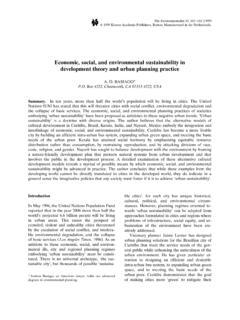

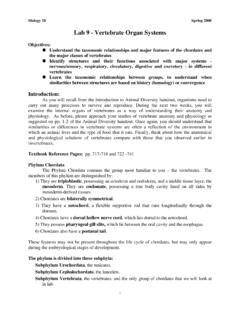
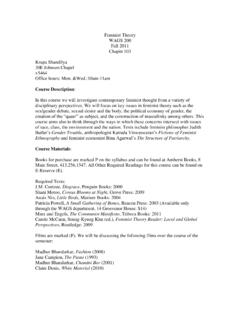

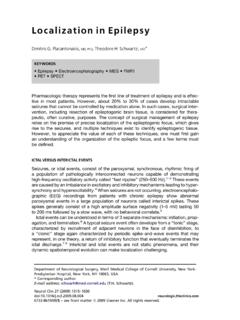
![[Fill-in-the-blank] tests measure and multiple choice ...](/cache/preview/5/e/e/9/b/f/1/7/thumb-5ee9bf17e1539b3a63fea89d05cad259.jpg)
